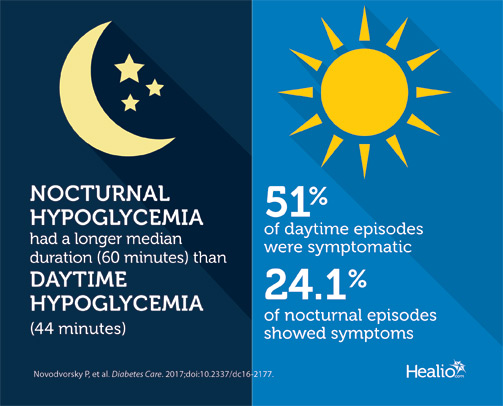Daytime, nocturnal hypoglycemia show differences in risk for cardiac arrhythmia in type 1 diabetes
Asymptomatic hypoglycemia is common, and daytime and nocturnal hypoglycemia produce differences in arrhythmic risk and cardiac repolarization among young adults with type 1 diabetes, data published in Diabetes Care indicate.
It has been nearly 30 years, according to the researchers, since “dead in bed” syndrome among young people with type 1 diabetes was first described.
“Given the fact that nocturnal hypoglycemia is very common and sudden deaths in type 1 diabetes are rare, an interplay of several factors, such as overt or undetected autonomic neuropathy, genetic contribution or abnormally intensive sympathoadrenal response, is likely to contribute [to dead in bed syndrome],” Peter Novodvorsky, MUDr, PhD, of the department of oncology and metabolism at the University of Sheffield, United Kingdom, and colleagues wrote. “The aim of this study was to examine the effect of clinical hypoglycemia in young people with type 1 diabetes — compared with matched euglycemia — on the frequency of cardiac arrhythmias, [heart rate variability] and cardiac repolarization. We particularly sought to compare differences between nocturnal and daytime hypoglycemia given the ... diurnal differences in sympathetic adrenomedullary responses to hypoglycemia.”
The researchers conducted simultaneous ambulatory ECG and masked continuous interstitial glucose monitoring on 37 patients with type 1 diabetes, carrying out 96 hours of monitoring on each patient and recording instances of symptomatic hypoglycemia. All patients were aged 50 years or younger. Novodvorsky and colleagues measured the frequency of arrhythmias, heart rate variability and cardiac repolarization during hypoglycemia, and compared the data with time-matched euglycemia.
Researchers obtained 2,395 hours of ECG and CGM recordings, of which 159 hours were hypoglycemia and 1,355 were euglycemia. Nocturnal hypoglycemia had a longer median duration (60 minutes) than daytime hypoglycemia (44 minutes; P = .02). Although 51% of daytime episodes were symptomatic, just 24.1% of nocturnal episodes showed symptoms, the researchers wrote. Bradycardia occurred more frequently in episodes of nocturnal hypoglycemia than in matched euglycemia (incident rate ratio [IRR] = 6.44; 95% CI, 6.26-6.66). Bradycardia was less frequent in daytime hypoglycemia (IRR = 0.023; 95% CI, 0.002-0.26), whereas atrial ectopics occurred more frequently (IRR = 2.29; 95% CI, 1.19-4.39). Nocturnal and daytime hypoglycemia both showed prolonged QT interval, T-peak to T-end interval duration and decreased T-wave symmetry, according to Novodvorsky and colleagues.
“We have shown a contrast in the frequencies of arrhythmias and cardiac electrophysiological responses during nocturnal compared with daytime hypoglycemia,” the researchers wrote. “We confirm [a high frequency] of hypoglycemia, particularly of nocturnal asymptomatic episodes among young people with type 1 diabetes, and our data add to the body of evidence suggesting that hypoglycemia is proarrhythmogenic.” – by Andy Polhamus
Disclosure: Novodvorsky reports no relevant financial disclosures. Please see the full study for a full list of all other authors’ relevant financial disclosures.


